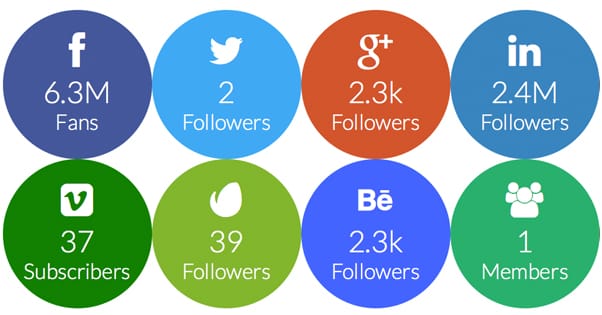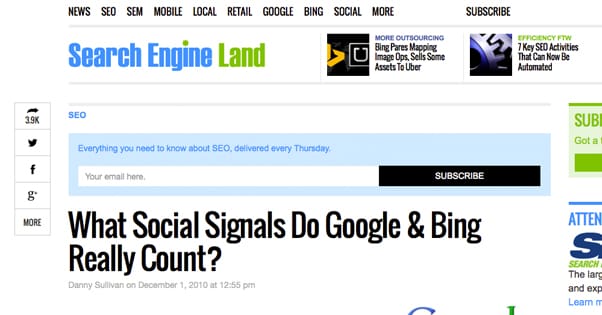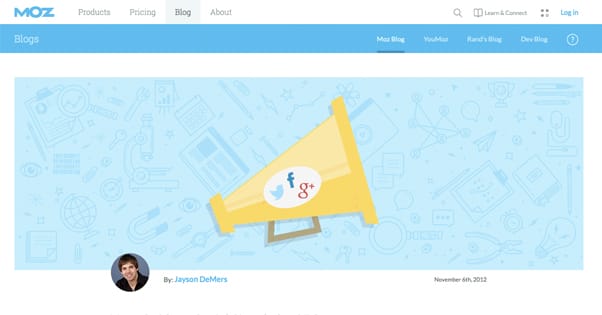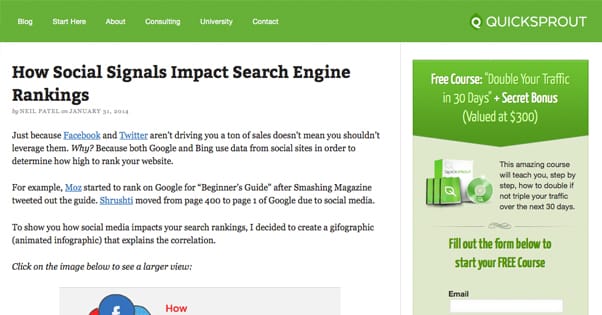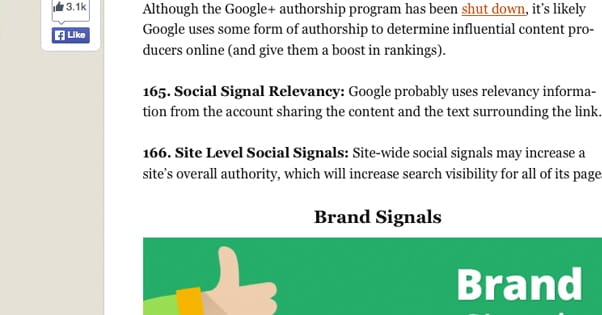Does Google Look at a Website’s Social Signals for SEO?
Published by James Parsons • Search Engine Optimization • Posted July 4, 2015 ContentPowered.com
ContentPowered.com
It’s clear that social media is beneficial to a business. You get a lot out of it. You get advertising, you get engagement, you get customer satisfaction. You get paid marketing so cheap it’s practically free, if you want it to be, and it scales well with money.
One thing that you may or may not get is a benefit to your website. Or, rather, a direct search engine benefit. Social signals do benefit your website; more shares means more people see it, which means more people click through to it, which means you have more traffic and all the benefits that entails.
The only question is; how much does Google care? Does Google monitor your traffic as a ranking factor? Do they tally up your shares on Facebook, on Google+, on Twitter, or on any other network? Are some networks better than others? To find out, we need to look into history.
December of 2010
Danny Sullivan of Search Engine Land wrote a piece published December 1, 2010, titled “What Social Signals Do Google & Bing Really Count?” In it, he explored what we knew of the search algorithms at the time, and what social signals mattered. I’m going to largely ignore Bing here, though you can assume that much of what Google does, Bing goes on to mirror.
The first thing to come up is something called the Google Social Search. You won’t find much about this if you look it up now, but in 2010, it was huge in Google’s prediction of the future. Social Search was an implementation of Google search that factored in your connections on social networks. Specifically, it worked for Google+ and Twitter. This was back when Google had a direct line to Twitter’s database, before the snafu where the social microblogging platform cut off access and left Google in a lurch.
Today, if you’re searching the Internet, you pretty much won’t see a single bit of Social Search left over. Where Google dreamed of friend pictures, names and network shares in their search results, you find only the normal search.
Some of these features do still exist, though they have changed a lot over the years. They disappeared from any network other than Google+, for one thing. Google couldn’t afford to build a system reliant on a third party only to have that third party cut off access. Once bitten, twice shy. So, reliant on Google+ alone, they rolled these features into Authorship. Then, when Authorship died, they kept a few of those features as gimmicks of Google+ and Google News.
All of that is beyond the scope of Sullivan’s article from five years ago, though. Back to it.
Another factor in search back then was Twitter authority, again due to the close relationship between Twitter and the search engines. This was part of the foundation of social search, and of Google’s realtime search experiment, both of which have been discontinued. The determination, though, is that social search is distinct from normal web search. A user could opt in to it through a special social search, but the normal index and algorithm seemed to consider very little of what social signals existed at the time. Interestingly, for realtime search, links from Twitter in particular were followed, which did pass some authority and did count for ranking.
Sullivan brings up the point of difference between web authority and human authority. What a lot of humans consider authoritative may not be what is objectively authoritative, given the 200+ ranking factors Google considers.
Sullivan asked Google several questions in emails, and got some interesting responses. Among them, Google confirmed that they did at the time use Twitter shares as an organic factor in search ranking. They treat Facebook shares the same way, though they didn’t have access to the same sort of “firehose” of data they got from Twitter.
The love story didn’t last, however; in 2011, Google’s deal with Twitter for the firehose and realtime search was cut off. This had a dramatic effect on both the realtime search and Google’s integration of social signals in organic results.
November 2012
In November of 2012, Jayson DeMers – CEO of AudienceBloom and poster on YouMoz – published an article titled “Your Guide to Social Signals for SEO” to Moz’s community forums. He analyzed Sullivan’s article and the then-modern trends for social in search.
His conclusion, presented up front, is that social signals did in fact affect organic search results, in both a direct and indirect way. Indirect, of course, is the same sort of audience growth and traffic engagement that I mentioned all the way back in the intro. Direct effect came from Facebook likes, Twitter followers, shares on Facebook, Tweets mentioning your brand or a link to your site, and people in circles on Google+. He also adds positive reviews to the indirect impact list, such as the increase in positive posts on Yelp and Google Local.
Now, what about his own predictions for the future, for today? Is he accurate? Here’s what he says, summed up:
- Social signals are becoming the new “link” in terms of importance.
- Links won’t completely disappear, but social signals will surpass them in value.
- The world is becoming more social by the day. More and more consumers, and thus more brands, will be using social networks for marketing and communication.
- People tend to trust recommendations from friends over anonymous recommendations, even when those recommendations are implied by Google’s ranking order.
- Brands with strong social presences tend to inspire more loyalty, more referrals, and more sales.
He then links this in to the riding importance of AuthorRank. Authorship and AuthorRank were good ideas, but from our position in the future, we can see that Authorship didn’t quite work out. AuthorRank still exists and is likely part of the algorithm, but it’s not really something you can point to on the search results page like it was when it included Google+ information.
January 2014
Now we’re getting to a more recent era in search history. Published a mere year and a half ago, Neil Patel’s article on Quicksprout titled “How Social Signals Impact Search Engine Rankings” is our next destination.
He immediately starts off with the importance of social signals as ranking factors by citing a Moz article attaining prominence after it was tweeted by Smashing Magazine. Of course, he then goes on to try to coin the term “gifographic” so, you know, I’m not sure I can trust the guy’s information. Gifographic? Really? Not Infogif? Ten seconds, Neil.
Anyways, getting to his graphic, he presents the case study of Indian SEO company Shrushti. This company decided to try an experiment, to get a page on their site to rank for a particular keyword using social signals alone. Their campaign led them to get numerous references on social networks, but no direct backlinks. To make matters worse for them, their page had some duplicate content on it, though I’m not sure that Google counts a meager two lines as duplicate enough to care about. There are, after all, a finite number of ways you can manipulate words in orders that make sense. A massive number, but a finite number nonetheless.
In measurements, Shrushti’s page went from 400 to 1 for ranking on that keyword. Now, being as this is an infographic from nearly two years ago, I don’t know if there was any wider context for the case study. Neil doesn’t present much in the way of facts. When he says no backlinks, does he mean the social networks never linked to the site, or that the only incoming links were from social networks?
I also question how much the ranking had to do with social signals, and how much of it came from the rest of the site. I mean, you use a keyword on a page, Google indexes that page, and Google ranks it. It’s naturally going to jump around as Google determines the best place for it. For a specific low-competition keyword on an otherwise authority site, it’s probably going to settle near the top, regardless of social signals. I’m not saying social signals don’t help; I’m just saying context matters too.
He goes on with the Moz example, the one with Smashing Magazine I mentioned above. This one he actually has data for; a Google Analytics chart showing traffic, with the time of the tweet posted. I have a few questions about this data too; when was the guide posted, when was it indexed? It’s clear that a bunch of incoming traffic and links from Smashing Magazine’s Twitter account and the subsequent retweets had some effect, though, which supports the claim.
Skipping past Neil Patel and on to Matt Cutts, we have a post on Search Engine Watch referencing a video of his about this exact subject. It, too, is from 2014, and sheds some light on the situation. Specifically, “Facebook and Twitter pages are treated like any other pages in our web index.” (Source)
In other words, a link from Twitter or a link from Facebook is a valuable link, with or without nofollow attached. It’s not treated any differently, other than the natural realization that a thousand links from shared posts on Facebook aren’t duplicate content or spam, that’s just how social networks function. He goes on to clarify that having X Twitter followers or Facebook fans isn’t a signal, as far as he knows.
All of that was still the beginning of 2014. That was a year and a half ago; how do things look now?
The Modern Outlook
The first thing to notice is that there hasn’t been a fresh statement from Matt Cutts on the subject. In fact, there’s been very little from Matt himself, since he’s been on leave since last July. So, you know, that puts our inside look at Google a little harder to get.
One commonly referenced and largely criticized post is Backlinko’s “complete list” of Google ranking factors. I both love and hate this post, because as comprehensive as it is, a lot of it is conjecture and it covers basically anything that could possibly be a factor.
In their section on social signals, we have a lot of information. Tweets, Facebook shares, Pinterest Pins and other such social signals are “likely considered” by Google as search factors, to which I say, of course they are. If 1,500 people on Facebook are linking to your website, that’s 1,500 links from a high quality domain. Now, not all links are created equal, and the authority of the person doing the linking might be a factor as well.
I say might, here because there’s not much in the way of data to verify this. Here’s my theory. I think authority exists for social media accounts, in two different ways. In addition to the normal account, you have verified accounts and authoritative accounts. I think Google has built a list of social media accounts that it will consider authoritative, and gives links from those accounts a bit more weight. I think they also have a system in place that estimates authority based on account factors, like follower count, number of tweets, age of the account, and whether or not the person is represented as an authority elsewhere. So, a prominent blogger with a new Twitter account might have some authoritative rank from that new account despite not having many followers, tweets, or past history.
Now, this is completely conjecture on my part. I’m perfectly open to the idea of being wrong. There’s one thing certain, however, and that’s the fact that Google does consider social signals in some form or another. I’m just adding on the idea of the quality of those social signals having an impact as well.
Google+ is a special case, by the way. As the only social network directly controlled by Google – if you discount Orkut before it shut down – it has a special place and a special role.
For one thing, as I mentioned back in the first section, remnants of Social Search still exist in the form of Google+ personalized results. They don’t consider data from Facebook or Twitter or any of the rest for that purpose, but they do consider authoritative people from Google+. You can, by the way, turn these off; there’s a silhouette of a person next to a globe, and if you click the globe, it turns your results into impersonal global results.
Google+ also has the ability to be a secondary source of information for Google. If you want a post to be indexed quickly, for example, you can submit it to Google+. They’ll notice the new link and send a crawler right over. It’s most helpful for smaller sites than for larger sites which are crawled on a daily or hourly basis, but it’s still valuable.
Boosting Social Signals for Fun and Profit
So if social signals are at the very least valuable indirectly, and are very likely valuable in a direct way as well, how can you get more out of social media without, you know, paying directly for a lot of advertisement?
- Post a link to be shared every time you post a new article. You can’t always rely on your readers sharing your posts; you need to get the party started. A 1 in the sharing bar is much better than a 0, even if the 1 is just you. If you have employees, writers, personal accounts, or anything else that can also share the post, use those too.
- Connect with influencers in your industry and try to get them to share your content. Just being connected to the giants of industry will help you, as people will see that you’re in the same communities and will associate you with them. If you can get their attention and get them to share your content, it’s an inconceivable help.
- Join niche communities like public Facebook groups and Google+ communities. You can join private Facebook groups as well, but they aren’t publicly indexed and don’t help with your sharing directly. They might, however, help other users find and share your content.
- Use niche hash tags for your tweets to get more people to see and share them. Always make sure you’re using hashtags properly, of course; you don’t want to be ambushed by a community that thinks you’re invading their tag with irrelevant information and advertising.
- Don’t be afraid to give your content a second or third run through the wringer over the week after it’s been posted. This is particularly relevant on Twitter, where a lot of your audience can miss it the first, second and third times around. Post at different times over the course of a few days, to get maximum exposure.
- Feel free to resurrect and share old content when it becomes relevant again. For example, sharing a few old posts about social signals in SEO when you’re talking about social signals in SEO. If this topic has some change-up, you could expect at least one of the posts I linked, and maybe this post, to get a new round of promotion.
- Include share buttons and share calls to action in your content and on your site. Some users will find your content through social media from the start, and others will find it through RSS or organic search. You should make it easy for the latter group to share your posts, by including social sharing buttons.
- Build and maintain social accounts on other networks, so long as you can support them. That secondary clause is key; if you can’t support all of what you’re doing, you need to refocus. Nothing kills social signals more than not giving social networks the attention they need to thrive. Don’t go out today and try to register for a dozen different sites expecting to successfully run all of those profiles simultaneously.
- Engage with users who comment to keep generating stories. On Facebook, for example, when someone comments on a post it generates a story for their friends. This is rarer than it used to be, but it still exists, and it’s a valuable way to get more exposure and shares.
- Curate content from other influencers to make your profile the best one to follow. If you’re posting all your content and no content from anyone else, people can follow you if they want your content but nothing else. On the other hand, if you post content from other influencers as well as your own, they can follow you instead of following you, those influencers, and other accounts. It makes you more exclusive, more valuable.
Keep up your social presence, share your posts as much as feasible, and get as many legitimate followers as you can. More social signals will result in benefits for your site, whether or not they directly influence SEO.
